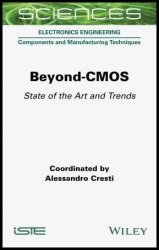Beyond-CMOS: State of the Art and Trends
- Добавил: literator
- Дата: 12-08-2023, 22:18
- Комментариев: 0
 Название: Beyond-CMOS: State of the Art and Trends
Название: Beyond-CMOS: State of the Art and TrendsАвтор: Alessandro Cresti
Издательство: Wiley-ISTE
Год: 2023
Страниц: 448
Язык: английский
Формат: epub (true)
Размер: 19.5 MB
Recent advances in physics, material sciences and technology have allowed the rise of new paradigms with bright prospects for digital electronics, going beyond the reach of Moore’s law, which details the scaling limit of electronic devices in terms of size and power. This book presents original and innovative topics in the field of beyond CMOS electronics, ranging from steep slope devices and molecular electronics to spintronics, valleytronics, superconductivity and optical chips.
Written by globally recognized leading research experts, each chapter of this book will provide an introductory overview of their topic and illustrate the state of the art and future challenges. Aimed not only at students and those new to this field, but also at well-experienced researchers, Beyond-CMOS provides extremely clear and exciting perspectives about the technology of tomorrow, and is thus an effective tool for understanding and developing new ideas, materials and architectures.
The first four chapters are devoted to steep-slope devices and low-power applications, which are one of the most important domains of Beyond CMOS electronics. The other chapters present more unconventional emerging technologies.
More specifically, Chapter 1 presents the possible use of III–V semiconductors in tunnel field-effect transistors for steep-slope applications, in particular regarding their limits and advantages by numerical simulations of these devices.
Chapter 2, written by Mathieu Luisier (ETH, Zurich, Switzerland) and co-workers, illustrates the possible use of 2D materials for field-effect transistors, not restricted to transition metal dichalcogenides. 2D materials have the advantage of being extremely thin (few atomic layers), thus allowing a good electrostatic control and flexible applications.
In Chapter 3 illustrate the working mechanism and the implementation of steep-slope devices based on the negative capacitance properties of the gate obtained using ferroelectric materials. The author has a particularly critical view on the subject, which will be helpful to present the practical applications of this technology to the reader.
In Chapter 4 presents the exotic zero subthreshold swing and zero impact ionization field-effect transistor (Z2-FET) based on the silicon-on-insulator technology. This kind of steep-slope device is particularly promising, among other things, for applications in memories.
In Chapter 5, the field of 2D spintronics is deeply analyzed, especially from the experimental point of view. In this chapter, the term “2D” refers to both 2D materials, 2D electron gases and 3D topological insulators, with applications ranging from memories to spin transport logic.
A more exotic subject is presented in Chapter 6, which illustrates the possible use of the valley degree of freedom and valley excitons in electronics. This innovative technology, based on the fact that an electron can occupy different valleys in the band structure, is still premature, but has important perspectives for logic operations and beyond, up to quantum computing.
Electronics can also be implemented through molecular systems. Chapter 7 is devoted to this emerging technology, which is very promising for the ultimate miniaturization of electronics. The strength of such a technology is incredibly large and varies from the implementation of standard logic devices to plasmonics and thermal transport.
Another innovative field is superconducting quantum electronics, presented in Chapter 8. Several very promising applications of superconductivity in the field of beyond CMOS electronics, including the realization of logic devices, neuromorphic computing and superconducting qubits, are presented.
Finally, a completely alternative technology, which consists of using light instead of electrons for the logic operations, is described in Chapter 9. Being able to integrate these operations in a single chip is a major advance towards applications, including massively parallel computing and efficient neural networks.
The aim of this book is to provide the reader with a fresh overview of the major research advances in this field, especially in Beyond CMOS logic devices, and a detailed physical insight into new trends that are inspirational for future devices.
Скачать Beyond-CMOS: State of the Art and Trends
Внимание
Уважаемый посетитель, Вы зашли на сайт как незарегистрированный пользователь.
Мы рекомендуем Вам зарегистрироваться либо войти на сайт под своим именем.
Уважаемый посетитель, Вы зашли на сайт как незарегистрированный пользователь.
Мы рекомендуем Вам зарегистрироваться либо войти на сайт под своим именем.
Информация
Посетители, находящиеся в группе Гости, не могут оставлять комментарии к данной публикации.
Посетители, находящиеся в группе Гости, не могут оставлять комментарии к данной публикации.
